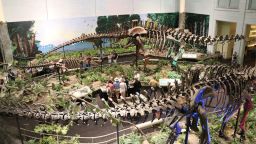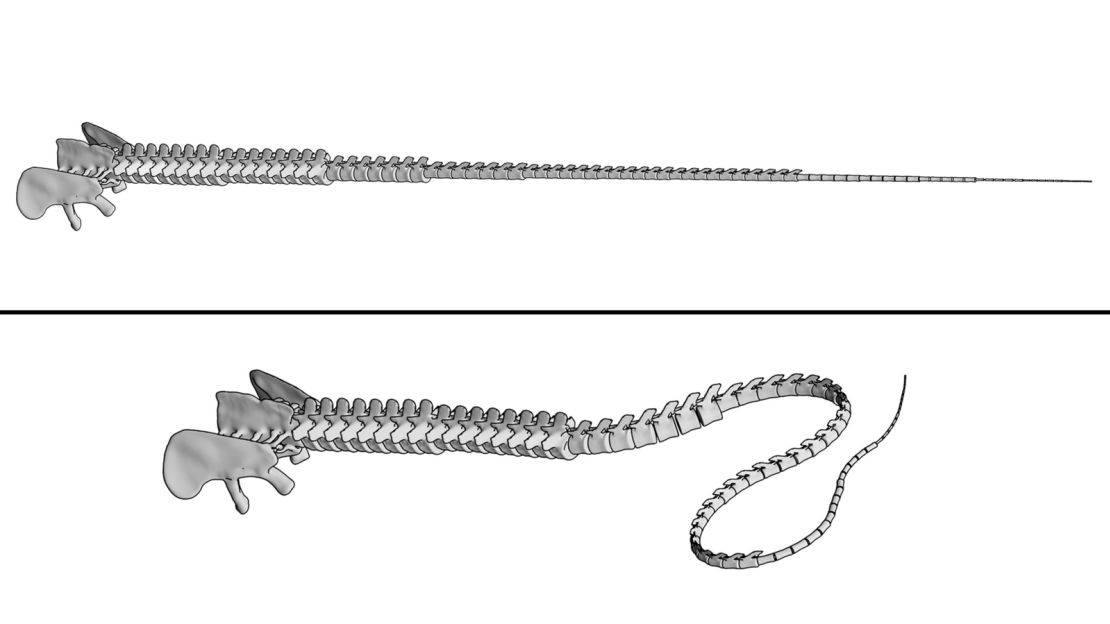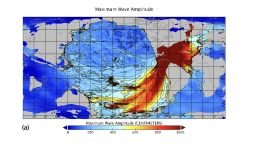Sign up for CNN’s Wonder Theory science newsletter. Explore the universe with news on fascinating discoveries, scientific advancements and more.
Diplodocids were a family of dinosaurs with long necks and, often, even longer tails — some species’ tails reached 50 feet in length. They were wide-ranging, but especially flourished in what’s now the western US around 152 million years ago.
For decades, scientists have debated whether these dinosaurs could whip their tails faster than the speed of sound, creating a sonic boom.
The sound of a cracking whip is actually a sonic boom. When something — a whip, a plane, or a dinosaur tail, for example — moves through the air, it creates pressure waves. If the moving object is traveling faster than the speed of sound, around 767 miles (or roughly 1,235 kilometers) per hour, then the pressure waves can’t keep up with the object, and they are compressed together like water in the wake of a speedboat. This compression produces a shock wave, and when that shock wave reaches an observer’s ear, they will hear all the compressed pressure waves associated with the object’s movement at once: a sonic boom.
The most recent study, published in Scientific Reports, suggests that while these dinosaurs’ tails couldn’t break the sound barrier, they could still move very fast — and be used to defend against predators.
Dueling dinosaur tails
For more than a century, scientists hypothesized diplodocid dinosaurs like Diplodocus and Apatosaurus (debatably, the more correct name for Brontosaurus) might have whipped their long, skinny tails around as a means of defense or even communication, but it wasn’t until 1997 that researchers published a case for the tails making a whip-crack sound. Then-chief technology officer of Microsoft and amateur paleontologist Nathan Myhrvold had become interested in the physics of cracking whips, and reached out to University of Alberta paleontologist Philip Currie to ask if a diplodocid’s tail could make a similar sound.

“I gave him all kinds of information on measurements for sauropod tails,” said Currie. “He started computer modeling it to see what he could do with it. And ultimately, it showed, certainly to my satisfaction, that these things almost certainly broke the sound barrier.”
To go along with the computer model published in 1997, Myhrvold and Currie built a 12-foot-long working model of a diplodocid tail out of steel and aluminum, and added a fringed “popper” from the tip of a bullwhip, which helps a whip attain its sound barrier-breaking speeds. Their model, which they unveiled in 2015, was indeed able to make a whip-cracking sound: a sonic boom.
But the new research has a bone to pick with this model: namely, that metal behaves differently than bone (and flesh and skin).
“It would break apart”
A few years after Currie and Myhrvold unveiled their metal model, Simone Conti, a doctoral student in a joint paleontology-engineering program with Portugal’s Universidade Nova de Lisboa and Italy’s Politecnico di Milano, began building his own. Conti’s model was digital; he wanted to practice multibody simulation, a method for studying how different materials move. As proof of concept, Conti looked to Currie and Myhrvold’s sound barrier-breaking dinosaur tails.
Using open-source software, he tried to simulate a diplodocid tail moving at the speed of sound and included hypothetical constraints for the biomechanical properties of the dinosaur’s skin, bone, and flesh. He was surprised to see that it didn’t work.
“I kept getting errors that my simulation was not able to complete itself,” said Conti. “During the simulation, the joints were not able to hold in place. Basically, the tail would be disarticulated if we transferred the data from the model to life.”
The results puzzled Conti, because Myhrvold and Currie had argued the tail should be able to surpass the speed of sound. But he wasn’t able to successfully run a motion simulation without significantly lowering the speed at which the digital tail was being whipped.
He was finally able to get the dino tail to whip without breaking by significantly lowering the speed. “It was like 30 meters per second, so it’s not so slow, it’s like 100 kilometers per hour,” he said. That speed (roughly 69 miles per hour) is fast, but nowhere near the speed of sound.

Conti and his colleagues also examined the possibility of adding the fringed “popper” hypothesized by Myrhvold and Currie at the tip of the tail, even though no fossil evidence of such a tail tip has been found. That didn’t work. Neither did playing with the size of the tail or adding more tissue to its base.
Ultimately, Conti concluded in the new paper that the problem was the previous models, both metallic and computer-simulated, didn’t reflect the realities of what a dinosaur’s body could achieve, or withstand. “They have built this amazing metallic model of aluminum and steel, but the real problem is that organic materials are not able to sustain the same stresses that aluminum or even steel are able to sustain.”
A new start for tail research
Despite not being able to produce a sonic boom, Conti said it’s still plausible that a diplodocid’s tail would have been a useful tool in a fight and may have been used defensively.
Verónica Díez Díaz, a paleontologist at Berlin’s Museum für Naturkunde who was not involved with either Currie’s or Conti’s studies, said the new research is “amazing,” especially as it pertains to her work in dinosaur biomechanics. “Tails in general for dinosaurs have been somehow neglected in the biomechanical studies,” she said, and with the analyses in Conti’s paper, “now we have something more experimental.”
Myhrvold is far less complimentary. “They have no ‘findings’ of any value. Their model was not driven properly to demonstrate a cracking whip. So, what they proved is that they do not know how to model a bullwhip,” said Myhrvold, who told CNN he plans to respond to Conti’s paper with an updated model of his own.
Currie maintains it’s still possible that a dinosaur tail could have moved at sound barrier-breaking speeds, perhaps thanks to stronger skin or other soft tissues at the tip of the tail that paleontologists have yet to discover. However, he emphasized that the scientific process depends on researchers exploring and testing each other’s work; their conflicting findings ladder up to a better understanding of life on Earth.
“It’s important because we really don’t have a good sense of all of the specializations that dinosaurs got into,” he said. “Dinosaurs did some absolutely amazing things. And if we want to answer the big questions, sometimes you’ve got to answer the small questions as well.”
Kate Golembiewski is a freelance science writer based in Chicago who geeks out about zoology, thermodynamics and death. She hosts the comedy talk show “A Scientist Walks Into a Bar.”






